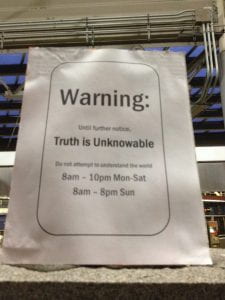A game where two players attempt to solve a jigsaw puzzle of Rene Magritte’s “The Lovers” while both players wear bags on their heads.

manning
Project 4 Pitch: Express Room
For my project, I want to build a 3D first-person game about expressing emotions. The player will navigate a series of small white rooms, using the buttons on their controller to “paint” each room with colors corresponding to the four core emotions of happiness, anger, sadness, and confusion. There are also four objects that the player can change based on the emotion that they express at it. Once they have changed all four objects, the game ends.
The Official Declaration of Uncertainty


For this piece, I made a sign declaring that truth is unknowable and that people should stop attempting to understand the world. The goal was to directly interfere with people’s assumptions about what they were capable of understanding. While the sign did get a few glances, it is not surprising that almost nobody completely stopped to read it, nor did they visibly care about its message.
Closed
Set up signs at various locations indicating that the locations and nearby objects are being closed for repairs. The key to this is that the “closed” places and objects are not places that never actually close down. The subjects would be small specific areas- for example, a 4 by 4 section of grass with a sign saying “Grass Closed for Repairs.”
The goal is to make people aware of their environment by taking parts of it away from them.
Appropriate – Manning
“Madmen’s Hack”

Two players take turns to move pawns with the intent of capturing their opponent by moving their pawn onto a space occupied by the opponent. The game is played on a computer keyboard, using the keys as you would a standard game board. The players’ movements are determined by asymmetric dice rolls; one player uses a single ten-sided die, while the other uses a pair of four-sided dice. The player must move their pawn onto a key that at least partially shares an edge with the key their pawn occupies at that moment, must move to as many keys as the number that they rolled on their die/dice, and may not move their pawn onto a key that it occupied at any other point in their turn. The computer must be turned on and have some key-operated program running, such as a word processor, video game, or online resources such as a virtual keyboard.
Manning Assignment 1: New Super BounceBall (Final)
Materials:
- One (1) semi-regular spheroid with a mass of 23.888×1024 kg and volume of 4.326×1012 km3 . Casual participants are allowed to substitute this spheroid with any one with sufficient volume that they can all play, but official tournaments must use a spheroid of the denoted proportions. If the spheroid is not equipped with a regulation breathable atmosphere, participants must provide their own.
- One (1) universe wherein corporeal sentient life is physically capable of existing for long enough to develop the cultural practice of play (batteries included).
- Participants, voluntary.
Instructions:
- Using one or more limbs each, all participants grip the same spheroid.
- At a predetermined signal (ex. referee’s whistle), all participants simultaneously shove the spheroid away from themselves as hard as they can.
- All participants then attempt to catch the spheroid as it falls back to them. Points are then distributed thus:
- Catching the spheroid using the same combination of limbs with which you initially gripped it: 10 points.
- Catching the spheroid with a different combination of limbs: 12 points.
- Failing to catch the spheroid: Disqualification.
- Repeat unless one or more participant/s are declared the winner.
“New Super BounceBall!! ™”
Materials:
- One (1) semi-regular spheroid with a mass of 23.888×1024 kg and volume of 4.326×1012 km3 . Casual participants are allowed to substitute this spheroid with any one with sufficient volume that they can all play, but official tournaments must use a spheroid of the denoted proportions. If the spheroid is not equipped with a regulation breathable atmosphere, participants must provide their own.
- One (1) universe wherein corporeal sentient life is physically capable of existing for long enough to develop the cultural practice of play (batteries included).
- One (1) self.
Instructions:
- Using one or more limbs each, all participants grip the spheroid.
- At a predetermined signal (ex. referee’s whistle), all participants shove the spheroid away from themselves as hard as they can.
- All participants then attempt to catch the spheroid as it falls back to them. Points are then distributed thus:
- Catching the spheroid using the same combination of limbs with which you initially gripped it: 10 points.
- Catching the spheroid with a different combination of limbs: 12 points.
- Failing to catch the spheroid: Disqualification.
- Repeat unless one or more participant/s are declared the winner.